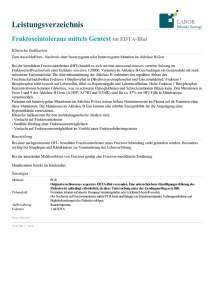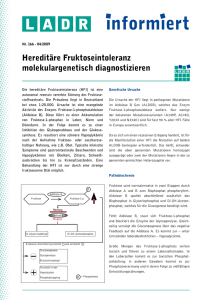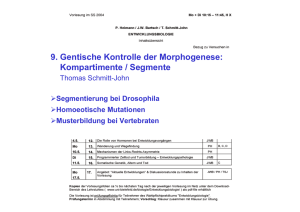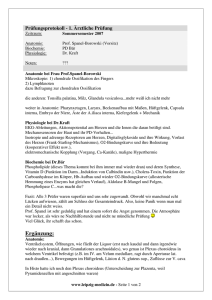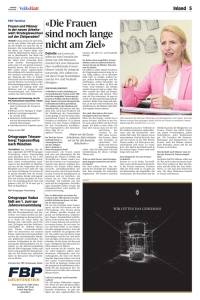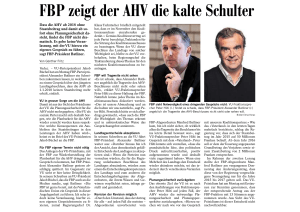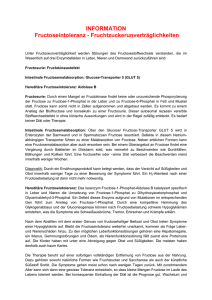FRUCTOSE-1.6-BISPHOSPHATE ALDOLASE - ETH E
Werbung
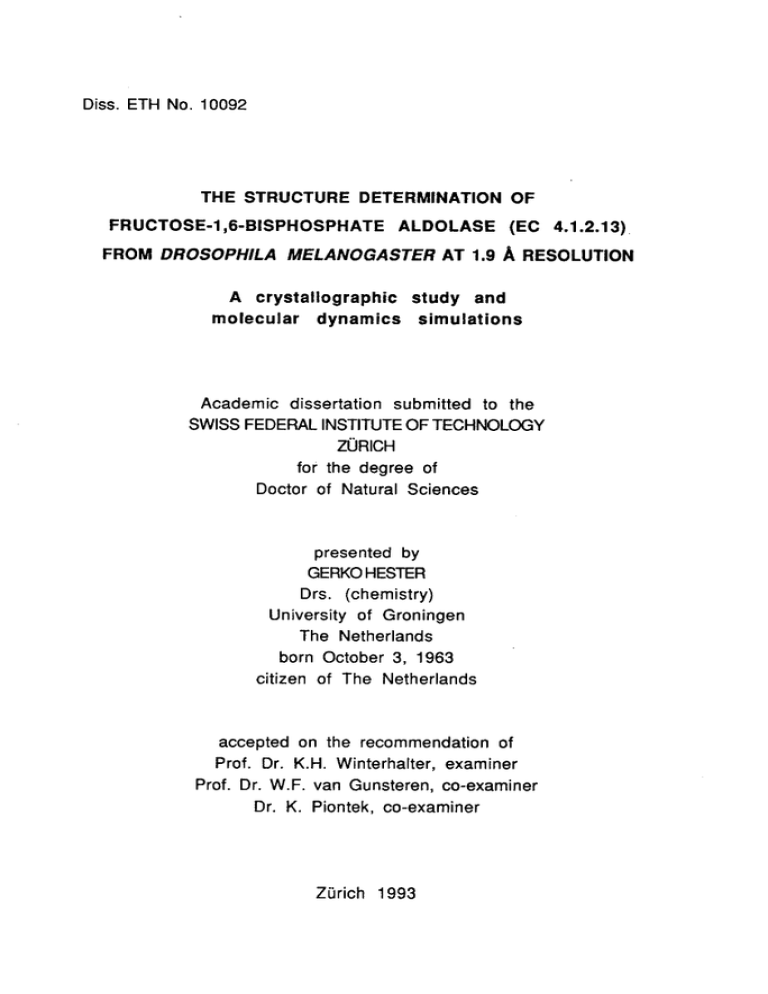
Diss. ETH No. 10092 THE STRUCTURE DETERMINATION OF FRUCTOSE-1.6-BISPHOSPHATE FROM DROSOPHILA A ALDOLASE MELANOGASTER AT 1.9 crystallographic study molecular dynamics Academic dissertation (EC 4.1.2.13) A RESOLUTION and simulations submitted to the SWISS FEDERAL INSTITUTE OF TECHNOLOGY ZÜRICH for the degree of Doctor of Natural Sciences presented by GERKO HESTER Drs. (chemistry) University of Groningen The Netherlands born October 3, 1963 citizen accepted of The Netherlands the recommendation of on Prof. Dr. K.H. Winterhalter, examiner Prof. Dr. W.F. Dr. K. van Gunsteren, co-examiner Piontek, co-examiner Zürich 1993 4 Summary Fructose-1,6-bisphosphate glycolytic (FBP) catalyzing enzyme fructose-1,6-bisphosphate of 158 Each kDa. 4.1.2.13) aldol reversible homotetramer This comprises subunit is a of cleavage dihydroxyacetone phosphate to glyceraldehyde-3-phosphate. weight (EC aldolase the has D- and molecular a single polypeptide a chain of 360 amino acids. In this work of crystals previously collected diffraction Drosophila aldolase, sofar the native separate batches, together to dataset a method replacement employing the post processed and were known applied structure of differences also from could be the with the last positions while in squares residues three was the the first method three an In investigate order to simulations Initially, as a The simulated final model Â. Except 4.0 to 2.5 was refinement refinement density map of fourfold real space into built of the this atomic annealing approach the restrained least comprises all molecular dynamics amino R-factor of 17.9%. were simulated: the of rounds used. was electron complete model a map. performed applying last acids and has were of phase extension from improved electron density aldolase problematic parts although structure quality crystal structure, density map showed unambiguous considerably improved by application averaging combined for original The present. were molecular The FBP rabbit muscle search model. The initial electron in merged and scaled the solve to the only processed  resolution. 1.9 to up was of data one 1-phosphate (F1P) substrate performed. binding Two enzyme-substrate complexes complex of Drosophila aldolase with fructose- and one complex Drosophila of aldolase with fructose-1,6-bisphosphate (FBP). The shows present analysis represents aldolase. structure a that homotetramer of However, it could might represent a the one not mixture determined of the be isozymes excluded of five crystal of that possible structure Drosophila the crystal tetramer types 5 differing terminal The in the residue The isomerase. of analysis aldolase-substrate possible hinge helix fourth basically has the structure phosphate helices. the from position the C- end. solved triose at type might the X-ray complexes its at be However catalysis together with the fold as are three that it giving for closing flexible and structure suggests N-terminus responsible same there the C-terminal enzyme extra the has flexibility. active a- simulated helix one intrinsic the site a This during arm. The crystal structure of Drosophila aldolase shows the presence of interactions strong hydrophobic has been identified particular offset between interactions residue stacked at one being as the along a interaction cis-proline. a subunit subunits subunit interface between is with dominating interface. The Proline 158 of this presence allow to necessary an tyrosines of neighbouring two subunits. We postulate (1) lysines three (3) lysine and phosphate binding sites 107 and 41 146 and which binds both results of the of Two proposed the regions active terminal are site Drosophila which is arm 41 is extra not is to phosphate groups of influence substrate second its flexibility cleavage formed suited for FBP and and the confirm F1P. compared specificity. One to binding which region FBP/F1P. by 42 and 303 separate binding site. dynamics simulations better of a aldolase for FBP the specificity through the reversible as molecular higher specificity aldolase arginine 148, (2) arginines therefore should be considered The in FBP. The discriminating Histidine 361 and either the glutamic acid transfer during intermediate 189 are substrate possibly directly influences The active site residue lysine the two to Tyrosine be 363 directly involved is an substrates. Ci-phosphate group of the substrate postulated catalysis. states. between C- affects present in vertebrate liver aldolases which might be factor is proposed to in or proton stabilize 6 Zusammenfassung Fruktose-1,6-bisphosphat glykolytisches Glyceraldehyd-3-phosphat Molekulargewicht die Dieses katalysiert. von ist 4.1.2.13) Spaltung reversible Dihydroxyacetonphosphat in Fruktose-1,6-bisphosphat einem (EC Aldolase welches Enzym und D- Homotetramer, mit kDA, besteht 158 ein von vier aus chemisch äquivalenten Untereinheiten. Jede Untereinheit enthält eine einzelne Polypetidkette In der von 360 Aminosäuren. vorliegenden Arbeit, Röntgendaten der prozessiert als kompletten Datensatz skaliert. Teile, bis Fruktose-1,6-bisphosphat Suchmodell verwendet Startphasen wurde welche eindeutige Suchmodell wurde. eine Elektronendichteverteilung ursprünglichen den in drei die Anfänglich drei Methode vorhanden des konnte die durch in der Qualität der Mittelung von Untereinheiten wurde Methode vollständiges ein Elektronendichtekarte annealing" Modells Verfeinerungsrunden eingesetzt wurde. ursprünglichen mit 4,0 auf 2,5  kombiniert. Abgesehen Das Substratbindungsstellen molekulardynamische Simulationen Substratkomplexe wurden simuliert: während von zu atomare für die in den squares" Modell enthält 17.9%. identifizieren, durchgeführt. ein least von werden. gebaut "restrained endgültige der atomares Methode verwendet, die alle Aminosäuren und hat einen R-Wert Um konnte als berechnet, Stellen Die waren. Diese "simulated atomaren dem nichtkristallographischen Aminosäuren die Muskel resultierenden problematische auch werden. verbesserte wurde Verfeinerung letzten vier der Phasen von letzten Modell der verbessert Ausdehnung Vergleich zu und des Struktur der bekannte daraus nur einem Methode Elektronendichtekarte im Elektronendichtekarte Elektronendichte die Kaninchen den Mit erste obwohl die aus zu zusamengefasst wurde wobei Aldolase Unterschiede zeigte, wesentlich  Auflösung 1.9 angewandt, Ersatzes vermessenen und prozessiert post Kristallstrukturbestimmung Zur molekularen einzelne die bereits früher wurden Drosophila Aldolasekristalle, bisher nativen Komplex Zwei mit wurden Enzym- Fruktose-1- 7 phosphat und (F1P) ein Fruktose-1,6-bisphosphat mit Komplex (FBP). gelöste Die bestehend Kristallstruktur Homotetramer, ein repräsentiert einem der Aldolase. Es kann der Isozyme Drosophila jedoch nicht ausgeschlossen werden, dass die Kristallstruktur ein Gemisch in aus fünf von möglichen Tetramertypen repräsentiert, die sich der viertletzten Aminosäure unterscheiden. Die Struktur hat im Wesentlichen die Triosephosphatisomerase, Strukturelementen. sich Untersuchungen dem an Strukturelemente, N-terminalen ein zusätzlichen drei darauf lässt befindet und der schliessen, dieser einer Ende, "Scharnier" helikalen Kristallstruktur der Aldolase-Substratkomplexe "simulierten" dass jedoch gleiche Faltung wie das Enzym mit helikalen welches erhöhte Flexibilität Die ermöglicht. Analyse der Kristallstruktur die Wechselwirkungen der Kontaktstellen, Prolin158 wird. Anwesenheit der Kontaktstellen verschiedene Drei cis-Prolin entlang einer zwei Untereinheiten identifiziert Aminosäurerestes, Untereinheiten, zwischen 107 und 146 und Die einer der an eine ermöglicht aromatische sich welche Tyrosinen, werden. in zwei befinden. welches 41 zu (1) Arginin 148, (2) Arginine 42 und 303 und (3) Molekulardynamische Spezifität die Simulationen Drosophila von Bereiche welche Phosphatgruppen von FBP bindet Bindungsstelle angenommen wurde. beiden deshalb als eine seperate Zwei Untereinheiten, Phosphatbindungsstellen wurden für Aldolasen postuliert: Lysine Lysin ein als speziellen dieses Drosophila Aldolase zeigt, dass den hydrophoben Wechselwirkungen dominiert von konnte Wechselwirkung der zwischen der Polypeptidkette wurden Substratspezifität bisphosphat. Dieser C-terminale beeinflusst Flexibilität reversible Der und hat Spaltung nicht vorhanden in die Arm zur den in die direkten Lysin 41, Leberaidolasen von F1P. zu Erwägung gezogen, ist von zweite Substratspezifität FBP/F1P. grössere Vergleich Eine Bindung stellt möglicherweise von im beeinflussen. Stelle, welche sich besser eignet die bestätigten Aldolase für FBP, und die aktive Fruktose-1,6- Region mittels Einfluss in der aktiven Wirbeltieren. dar. seiner auf die Stelle, ist Dies lässt 8 vermuten, bei der Histidin oder dass dieser Aminosäurerest 361 und entweder die Glutaminsäure Protonentransfer angenommen, dass 189 während Tyrosin ebenfalls eine Rolle spielt zwei Substrate. Diskriminierung der Ci-Phosphatgruppe sind der 363 des wahrscheinlich Katalyse beteiligt. Übergangszustände Substrates direkt Es stabilisiert. am wird
